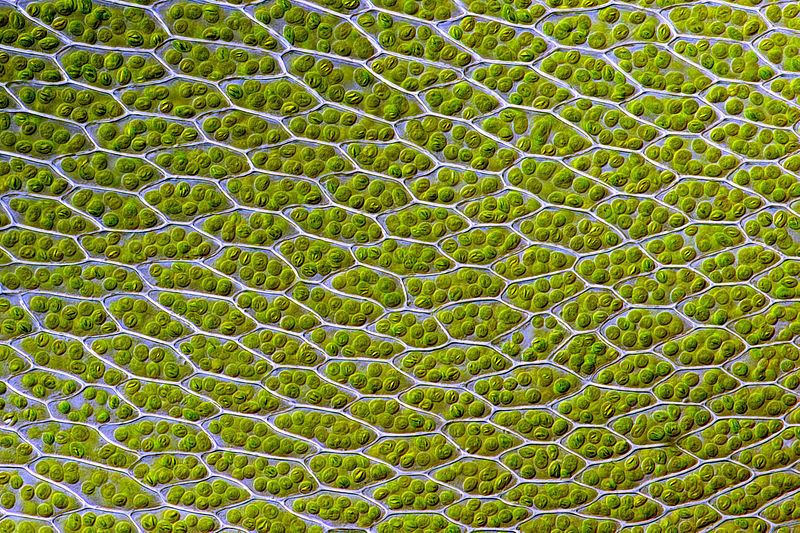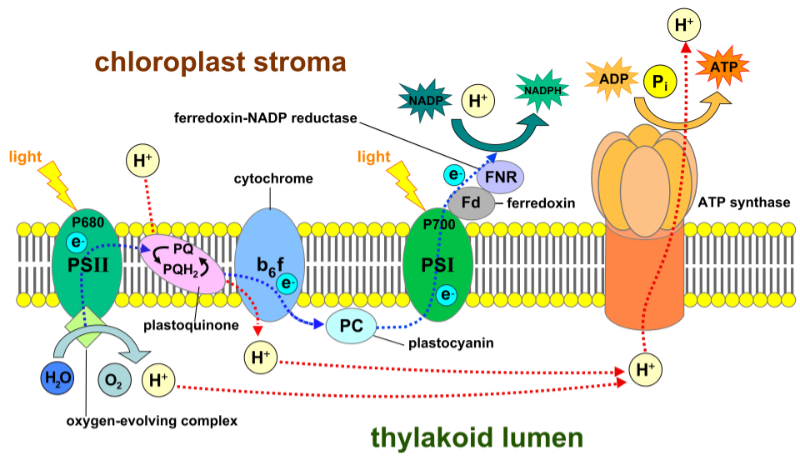Overview on the Light-Dependent Reactions of Photosynthesis
Photosynthesis can be broken down into the light-dependent reactions (which this entire section will cover), and the light-independent reactions (covered in the next section). Both occur within the chloroplasts of cyanobacteria, plants, and algae. Fig. 1 shows the chloroplasts in the cells of a moss species:

Attribution: Des_Callaghan, CC BY-SA 4.0 , via Wikimedia Commons
Chloroplasts contain structures called thylakoids, which are suspended in a fluid called the stroma. (Stacks of thylakoids are called grana — a singular stack is called a granum).
A simple representation of a chloroplast is shown in Fig. 2.

Attribution: Public Domain, https://en.wikipedia.org/w/index.php?curid=10483833
The light-dependent reactions are named not so much because they occur in the light (although they do), but because they are driven by the energy of photons within the visible light spectrum.
The light-dependent reactions occur within the thylakoid membranes, represented by the dark-green borders in Fig. 2. The thylakoid membrane is distinct from the chloroplast’s membrane, and keeps the internal part of the thylakoid, called the lumen, together. Thylakoid lumens are represented by the fluorescent-green ovals in Fig. 2.
Embedded, and spanning, the thylakoid membrane are four major protein complexes: photosystem II (PSII), cytochrome b6f complex, photosystem I (PSI), and ATP synthase (Fig. 3). The ‘chloroplast stroma’ and ‘thylakoid lumen’ labels mark the external and internal sides of the thylakoid membrane respectively.

Attribution: By Somepics - Own work, CC BY-SA 4.0, https://commons.wikimedia.org/w/index.php?curid=38088695
These four are called protein complexes as each is made of several protein subunits. All four will be covered in detail in the following pages, and we will see Fig. 3 many more times yet!
But here in this overview we can summarise the light-dependent reactions of photosynthesis as two processes:
- a flow of electrons is kickstarted by photon energy striking photosystems II and I. These electrons move through the thylakoid membrane and end in a molecule called Nicotinamide Adenine Dinucleotide Phosphate (NADPH/NADP+) in the chloroplast stroma. NADP+/NADPH, as the universal electron (e-) and proton (H+) carrier in life, then goes on to participate as an important cofactor in many biochemical reactions; and
- an accumulation of protons (H+ ions) arises in the thylakoid lumen. These H+ ions come from the splitting of water by photosystem II in the lumen, and via the cytochrome b6f complex pumping still more across the membrane from the stroma to the lumen. These H+ ions create a gradient of high (in the lumen) to low concentration (in the stroma) across the membrane, which in turn creates enough electrical potential to generate Adenosine Triphosphate (ATP), also in the stroma. ATP is the universal storage of energy in life, and vital for biochemical processes to occur at all.
A cyanobacterium, alga or plant — having produced NADP+/NADPH and ATP via photon energy — can now use these molecules to make carbohydrates from carbon dioxide. This part, the making of carbohydrate food, involves the light-independent reactions and will be covered more thoroughly in that section.
Please keep reading for a breakdown of how each of the components involved in the light-dependent reactions of photosynthesis just work — the beauty and complexity of life never ceases to amaze me!
About the Author
BSc(Hons), U.Syd. - double major in biochemistry and microbiology, with honours in microbiology
PhD, U.Syd - soil microbiology
Stumbled into IT and publishing of all things.
Discovered jujube trees and realised that perhaps I should have been an agronomist...
So I combined all the above passions and interests into this website and its blog and manuals, on which I write about botany, soil chemistry, soil microbiology and biochemistry - and yes, jujubes too!
Please help me buy a plant if you found this article interesting or useful!